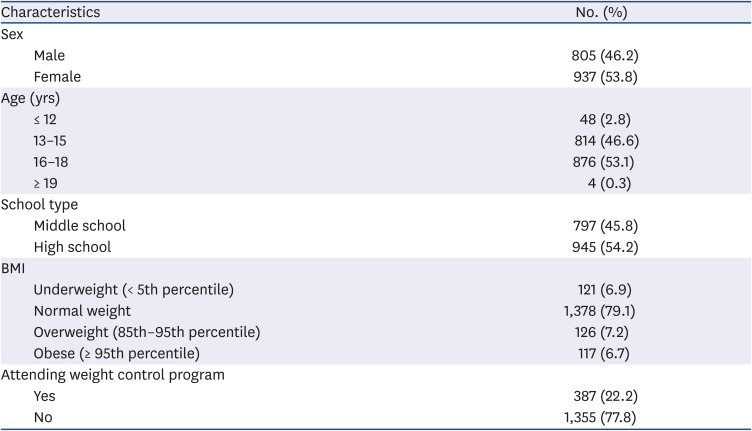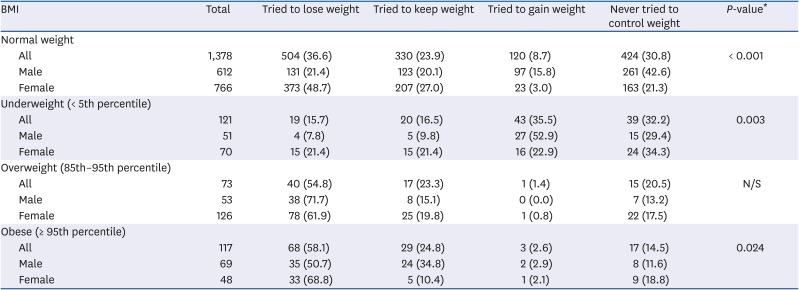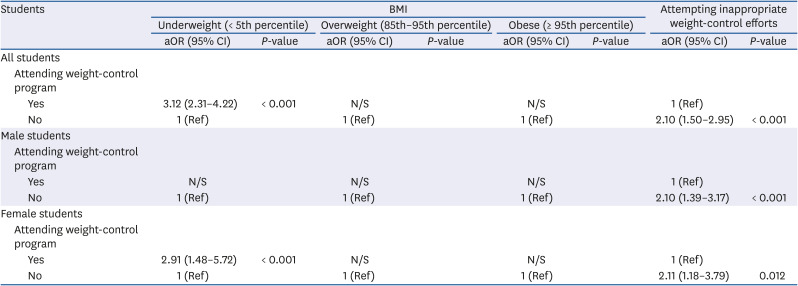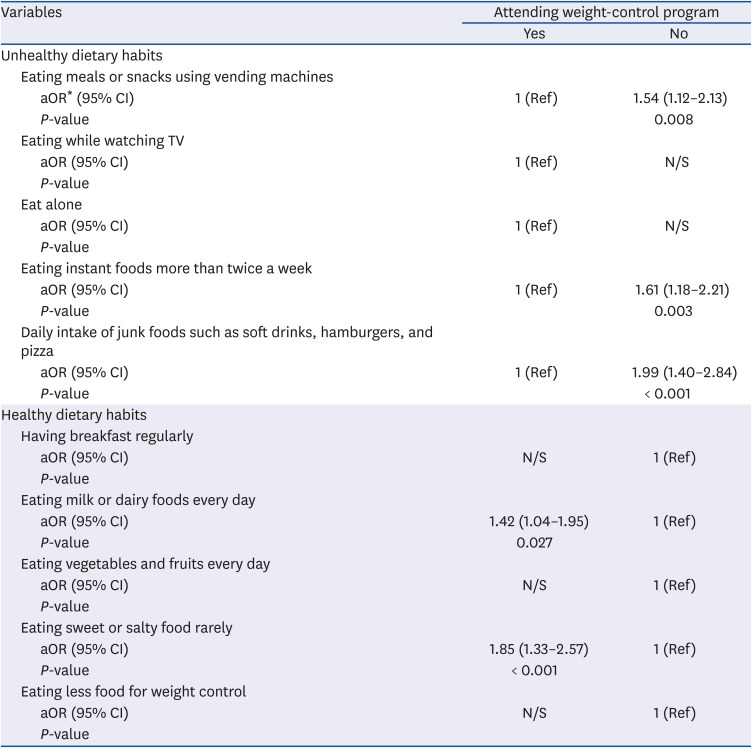1. Jung UJ, Choi MS. Obesity and its metabolic complications: the role of adipokines and the relationship between obesity, inflammation, insulin resistance, dyslipidemia and nonalcoholic fatty liver disease. Int J Mol Sci. 2014; 15:6184–6223. PMID:
24733068.

2. Hall ME, do Carmo JM, da Silva AA, Juncos LA, Wang Z, Hall JE. Obesity, hypertension, and chronic kidney disease. Int J Nephrol Renovasc Dis. 2014; 7:75–88. PMID:
24600241.

3. Cossrow N, Falkner B. Race/ethnic issues in obesity and obesity-related comorbidities. J Clin Endocrinol Metab. 2004; 89:2590–2594. PMID:
15181028.

4. Sulit LG, Storfer-Isser A, Rosen CL, Kirchner HL, Redline S. Associations of obesity, sleep-disordered breathing, and wheezing in children. Am J Respir Crit Care Med. 2005; 171:659–664. PMID:
15591475.

5. Krassas GE, Tzotzas T. Do obese children become obese adults: childhood predictors of adult disease. Pediatr Endocrinol Rev. 2004; 1(Suppl 3):455–459. PMID:
16444174.
6. Singh AS, Mulder C, Twisk JW, van Mechelen W, Chinapaw MJ. Tracking of childhood overweight into adulthood: a systematic review of the literature. Obes Rev. 2008; 9:474–488. PMID:
18331423.

7. Umer A, Kelley GA, Cottrell LE, Giacobbi P Jr, Innes KE, Lilly CL. Childhood obesity and adult cardiovascular disease risk factors: a systematic review with meta-analysis. BMC Public Health. 2017; 17:683. PMID:
28851330.

8. Wright CM, Parker L, Lamont D, Craft AW. Implications of childhood obesity for adult health: findings from thousand families cohort study. BMJ. 2001; 323:1280–1284. PMID:
11731390.

9. NCD Risk Factor Collaboration (NCD-RisC). Worldwide trends in body-mass index, underweight, overweight, and obesity from 1975 to 2016: a pooled analysis of 2416 population-based measurement studies in 128·9 million children, adolescents, and adults. Lancet. 2017; 390:2627–2642. PMID:
29029897.
10. Ha KH, Kim DJ. Epidemiology of childhood obesity in Korea. Endocrinol Metab (Seoul). 2016; 31:510–518. PMID:
27834078.

11. Organisation for Economic Co-operation and Development. Health at a Glance 2015. Paris: OECD Publishing;2015.
12. Lee Y, Shin HK, Choi BM, Eun BL, Park SH, Lee KH, Shin C. A survey of body shape perception and weight control of adolescent girls in three areas of Korea. Korean J Pediatr. 2008; 51:134–144.

13. Sivertsen B, Pallesen S, Sand L, Hysing M. Sleep and body mass index in adolescence: results from a large population-based study of Norwegian adolescents aged 16 to 19 years. BMC Pediatr. 2014; 14:204. PMID:
25128481.

14. Ambroszkiewicz J, Klemarczyk W, Rowicka G, Chelchowska M, Oltarzewski M, Gajewska J. Adipokines, body composition and bone mineral density in underweight children . Pol Merkur Lekarski. 2015; 39:18–22. PMID:
26277173.
15. Gao S, Juhaeri J, Reshef S, Dai WS. Association between body mass index and suicide, and suicide attempt among British adults: the health improvement network database. Obesity (Silver Spring). 2013; 21:E334–E342. PMID:
23592687.

16. Ibrahim C, El-Kamary SS, Bailey J, St George DM. Inaccurate weight perception is associated with extreme weight-management practices in U.S. high school students. J Pediatr Gastroenterol Nutr. 2014; 58:368–375. PMID:
24172585.

17. Kleiser C, Schaffrath Rosario A, Mensink GB, Prinz-Langenohl R, Kurth BM. Potential determinants of obesity among children and adolescents in Germany: results from the cross-sectional KiGGS study. BMC Public Health. 2009; 9:46. PMID:
19187531.

18. Ball EJ, O'Connor J, Abbott R, Steinbeck KS, Davies PS, Wishart C, Gaskin KJ, Baur LA. Total energy expenditure, body fatness, and physical activity in children aged 6-9 y. Am J Clin Nutr. 2001; 74:524–528. PMID:
11566652.

19. Arora M, Nazar GP, Gupta VK, Perry CL, Reddy KS, Stigler MH. Association of breakfast intake with obesity, dietary and physical activity behavior among urban school-aged adolescents in Delhi, India: results of a cross-sectional study. BMC Public Health. 2012; 12:881. PMID:
23075030.

20. O'Connor TM, Yang SJ, Nicklas TA. Beverage intake among preschool children and its effect on weight status. Pediatrics. 2006; 118:e1010–e1018. PMID:
17015497.
21. Yoon SS, Kim HJ, Oh KW. Dietary habits of Korean adolescents: results of Korea youth risk behavior web-based survey. Public Health Wkly Rep. 2014; 8:795–799.
22. Madsen KA, Cotterman C, Crawford P, Stevelos J, Archibald A. Effect of the healthy schools program on prevalence of overweight and obesity in California schools, 2006–2012. Prev Chronic Dis. 2015; 12:E77. PMID:
25996984.

23. Brown T, Summerbell C. Systematic review of school-based interventions that focus on changing dietary intake and physical activity levels to prevent childhood obesity: an update to the obesity guidance produced by the National Institute for Health and Clinical Excellence. Obes Rev. 2009; 10:110–141. PMID:
18673306.

24. Yin Z, Moore JB, Johnson MH, Vernon MM, Gutin B. The impact of a 3-year after-school obesity prevention program in elementary school children. Child Obes. 2012; 8:60–70. PMID:
22799482.

25. Niide TK, Davis J, Tse AM, Harrigan RC. Evaluating the impact of a school-based prevention program on self-esteem, body image, and risky dieting attitudes and behaviors among Kaua'i youth. Hawaii J Med Public Health. 2013; 72:273–278. PMID:
24349890.
26. Johnston CA, Moreno JP, El-Mubasher A, Gallagher M, Tyler C, Woehler D. Impact of a school-based pediatric obesity prevention program facilitated by health professionals. J Sch Health. 2013; 83:171–181. PMID:
23343318.

27. Yi DY, Kim SC, Lee JH, Lee EH, Kim JY, Kim YJ, Kang KS, Hong J, Shim JO, Lee Y, Kang B, Lee YJ, Kim MJ, Moon JS, Koh H, You J, Kwak YS, Lim H, Yang HR. Clinical practice guideline for the diagnosis and treatment of pediatric obesity: recommendations from the Committee on Pediatric Obesity of the Korean Society of Pediatric Gastroenterology Hepatology and Nutrition. Korean J Pediatr. 2019; 62:3–21. PMID:
30589999.

28. Fukai M, Kim S, Yun YH. Depression and suicidal ideation: association of physical, mental, social, and spiritual health status. Qual Life Res. 2020; 29:2807–2814. PMID:
32468404.

29. Yun YH, Sim JA, Park EG, Park JD, Noh DY. Employee health behaviors, self-reported health status, and association with absenteeism: comparison with the general population. J Occup Environ Med. 2016; 58:932–939. PMID:
27513170.
30. DeVault N, Kennedy T, Hermann J, Mwavita M, Rask P, Jaworsky A. It's all about kids: preventing overweight in elementary school children in Tulsa, OK. J Am Diet Assoc. 2009; 109:680–687. PMID:
19328263.

31. Hollar D, Messiah SE, Lopez-Mitnik G, Hollar TL, Almon M, Agatston AS. Effect of a two-year obesity prevention intervention on percentile changes in body mass index and academic performance in low-income elementary school children. Am J Public Health. 2010; 100:646–653. PMID:
20167892.

32. Melnyk BM, Jacobson D, Kelly S, O'Haver J, Small L, Mays MZ. Improving the mental health, healthy lifestyle choices, and physical health of Hispanic adolescents: a randomized controlled pilot study. J Sch Health. 2009; 79:575–584. PMID:
19909421.

33. Halfon N, Larson K, Slusser W. Associations between obesity and comorbid mental health, developmental, and physical health conditions in a nationally representative sample of US children aged 10 to 17. Acad Pediatr. 2013; 13:6–13. PMID:
23200634.

34. Hartmann T, Zahner L, Pühse U, Puder JJ, Kriemler S. Effects of a school-based physical activity program on physical and psychosocial quality of life in elementary school children: a cluster-randomized trial. Pediatr Exerc Sci. 2010; 22:511–522. PMID:
21242601.

35. Foster GD, Sherman S, Borradaile KE, Grundy KM, Vander Veur SS, Nachmani J, Karpyn A, Kumanyika S, Shults J. A policy-based school intervention to prevent overweight and obesity. Pediatrics. 2008; 121:e794–802. PMID:
18381508.

36. Wang MC, Rauzon S, Studer N, Martin AC, Craig L, Merlo C, Fung K, Kursunoglu D, Shannguan M, Crawford P. Exposure to a comprehensive school intervention increases vegetable consumption. J Adolesc Health. 2010; 47:74–82. PMID:
20547295.

37. Kim S, So WY. Prevalence and sociodemographic trends of weight misperception in Korean adolescents. BMC Public Health. 2014; 14:452. PMID:
24885579.

38. Liechty JM. Body image distortion and three types of weight loss behaviors among nonoverweight girls in the United States. J Adolesc Health. 2010; 47:176–182. PMID:
20638010.

39. Kim M, Lee H. Overestimation of own body weights in female university students: associations with lifestyles, weight control behaviors and depression. Nutr Res Pract. 2010; 4:499–506. PMID:
21286408.

40. Black RE. Patterns of growth in early childhood and infectious disease and nutritional determinants. Black RE, Makrides M, Ong KK, editors. Complementary Feeding: Building the Foundations for a Healthy Life. Basel: Karger AG Basel;2017. p. 63–72.
41. Nakamori M, Nguyen XN, Nguyen CK, Cao TH, Nguyen AT, Le BM, Vu TT, Bui TN, Nakano T, Yoshiike N, Kusama K, Yamamoto S. Nutritional status, feeding practice and incidence of infectious diseases among children aged 6 to 18 months in northern mountainous Vietnam. J Med Invest. 2010; 57:45–53. PMID:
20299742.

42. Park MH, Falconer C, Viner RM, Kinra S. The impact of childhood obesity on morbidity and mortality in adulthood: a systematic review. Obes Rev. 2012; 13:985–1000. PMID:
22731928.

43. Abdullah A, Wolfe R, Stoelwinder JU, de Courten M, Stevenson C, Walls HL, Peeters A. The number of years lived with obesity and the risk of all-cause and cause-specific mortality. Int J Epidemiol. 2011; 40:985–996. PMID:
21357186.

44. Caird J, Kavanagh J, O'Mara-Eves A, Oliver K, Oliver S, Stansfield C, Thomas J. Does being overweight impede academic attainment? A systematic review. Health Educ J. 2014; 73:497–521.

45. Kraak VI, Vandevijvere S, Sacks G, Brinsden H, Hawkes C, Barquera S, Lobstein T, Swinburn BA. Progress achieved in restricting the marketing of high-fat, sugary and salty food and beverage products to children. Bull World Health Organ. 2016; 94:540–548. PMID:
27429493.

46. Mellor D, McCabe M, Ricciardelli L, Yeow J, Daliza N, Hapidzal NF. Sociocultural influences on body dissatisfaction and body change behaviors among Malaysian adolescents. Body Image. 2009; 6:121–128. PMID:
19195942.










 PDF
PDF Citation
Citation Print
Print



 XML Download
XML Download